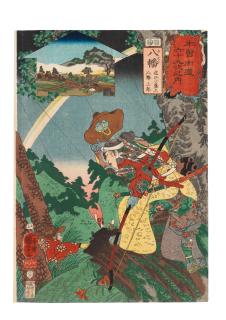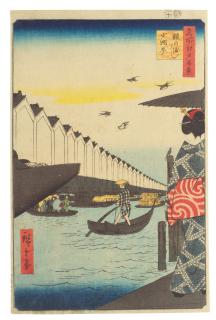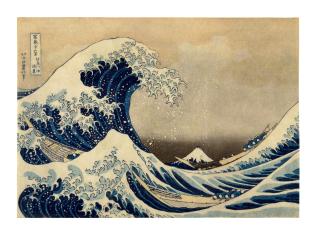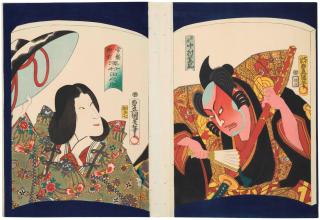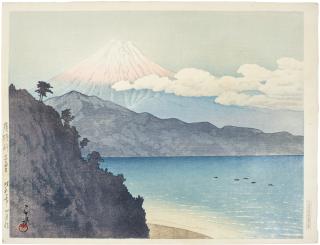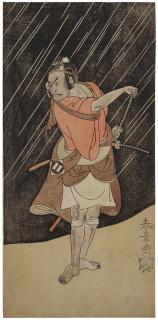Utagawa Kuniyoshi 1797 - 1861
The artist Utagawa Kuniyoshi
- One of three masters of Japanese woodblock printing (ukiyo-e) in the 19th century.
- His first work is said to have been a self-painted kimono in childhood.
- Defied censorship authorities along with the other two ukiyo-e artists.
Utagawa Kuniyoshi (1798 - 1861) is one of a total of three style-forming artists of Japanese woodblock printing in the so-called Edo period. He is considered the leading figure of ukiyo-e, a Japanese term that sums up both the attitude to life and the particular form of art printing at that time. Many details of his vita are disputed, especially since they come only from oral tradition.
Utagawa Kuniyoshis was born in 1798 as the son of a silk dyer in Edo, now Tokyo - his civil name is said to have been Ikusa Magosaburō. It is said that he helped his father with his work as a child and thus lived out his creativity. The story about a self-painted kimono, which he wore to a public festival and which caused a sensation, is still an integral part of the biography passed down to us today.
Because Kuniyoshi's father was a friend of the head of the Utagawa school, Utagawa Toyokuni I, it was possible for the son to take drawing and printing lessons with Toyokuni. Main motifs during the apprenticeship were scenes and actors of the Kabuki theater as well as illustrations of contemporary entertainment literature. The young artist received his pseudonym Utagawa Kuniyoshi from his teacher after he finished school.
Kuniyoshi made his living from art only hesitantly: he began with a few book illustrations and worked as a craftsman for a long time. It was not until 1827 that he received a commission from the publisher Kagaya Kichibei to illustrate the series The 108 Heroes of Suikoden. Because the pictures were so well received by the public, he received more and more commissions for hero depictions, book illustrations and also landscape prints, until around 1842 he had finally established himself as one of three leading figures in the style.
Kuniyoshi also came into conflict with the law, but resisted the censorship authorities: Together with the other two ukiyo-e representatives Kunisada and Hiroshige, he designed two series showing actors of the Kabuki theater in a heroic-mystical context, which was forbidden at the time - but unlike earlier printing plates, the authorities did not destroy them. And so the artists ultimately prevailed with this. After his success, Kuniyoshi was considered extremely wealthy and generous. He died in 1861 according to the European calendar.
Der Künstler Utagawa Kuniyoshi
- Einer von drei Meistern des japanischen Farbholzschnitts (Ukiyo-e) im 19. Jahrhundert.
- Sein erstes Werk soll ein selbstbemalter Kimono im Kindesalter gewesen sein.
- Widersetzte sich mit den anderen beiden Ukiyo-e-Künstlern den Zensurbehörden.
Utagawa Kuniyoshi (1798 – 1861) ist einer von insgesamt drei stilbildenden Künstlern des japanischen Farbholzschnitts in der sogenannten Edo-Zeit. Er gilt als führende Figur des Ukiyo-e, einem japanischen Begriff, der sowohl das Lebensgefühl als auch die spezielle Kunstdruckform zu dieser Zeit zusammenfasst. Viele Details seiner Vita sind umstritten, zumal sie nur aus mündlichen Überlieferungen stammen.
Utagawa Kuniyoshis wurde 1798 als Sohn eines Seidenfärbers in Edo, heute Tokio, geboren – sein bürgerlicher Name soll Ikusa Magosaburō gelautet haben. Es heißt, dass er seinem Vater schon als Kind bei der Arbeit geholfen und so seine Kreativität ausgelebt haben soll. Die Geschichte um einen selbstbemalten Kimono, den er zu einem öffentlichen Fest trug und der für Aufsehen sorgte, ist noch heute fester Bestandteil der überlieferten Biografie.
Weil Kuniyoshis Vater mit dem Oberhaupt der Utagawa-Schule, Utagawa Toyokuni I., befreundet war, war es dem Sohn möglich, Zeichen- und Druckunterricht bei Toyokuni zu nehmen. Hauptmotive während der Lehrzeit waren Szenen und Schauspieler des Kabuki-Theaters sowie die Illustration zeitgenössischer Unterhaltungsliteratur. Sein Pseudonym Utagawa Kuniyoshi erhielt der junge Künstler von seinem Lehrmeister, nachdem er die Schule beendet hatte.
Kuniyoshi bestritt seinen Lebensunterhalt nur zögerlich mit der Kunst: Er begann mit wenigen Buchillustrationen und arbeitete lange als Handwerker. Erst 1827 erhielt er den Auftrag des Verlegers Kagaya Kichibei die Serie Die 108 Helden des Suikoden zu illustrieren. Weil die Bilder beim Publikum so gut ankamen, bekam er immer häufiger Aufträge für Heldendarstellungen, Buchillustrationen und auch Landschaftsdrucke, bis er sich um 1842 endgültig als einer von drei führenden Köpfen der Stilrichtung etabliert hatte.
Kuniyoshi geriet auch mit dem Gesetz in Konflikt, widersetzte sich aber den Zensurbehördern: Zusammen mit den anderen beiden Ukiyo-e-Vertretern Kunisada und Hiroshige entwarf er zwei Serien, die Schauspieler des Kabuki-Theaters in einem heroisch-mystischen Kontext zeigten, was zur damaligen Zeit verboten war – im Gegensatz zu früheren Druckplatten zerstörte die Behörden diese aber nicht. Und so setzten sich die Künstler damit letzten Endes durch. Kuniyoshi galt nach seinem Erfolg als äußerst wohlhabend und großzügig. Er starb nach europäischem Kalender 1861.
Utagawa Kuniyoshi in a nutshell
Because Utagawa Kuniyoshi lived from 1797 to 1861, it is rare to find artworks by Utagawa Kuniyoshi for sale. There was a somewhat larger wave of auctions of Kuniyoshi paintings in 2007, and between 2018 and 2022 there were also more on average each year. Most of Utagawa Kuniyoshi's works, with a little luck, can be found in the usual art auction houses - there most of them fetch the equivalent of prices between 1,000 and 10,000 EUR.
A famous triptych by Utagawa Kuniyoshi shows a total of 55 cats in various actions. They crawl out of baskets, catch rats or eat fish. Kuniyoshi's special woodblock prints were part of the trendy pop culture at that time, which rich people afforded because of their hedonistic lifestyle. Kuniyoshi is one of the last proponents of the so-called ukiyo-e prints and he was a self-confessed cat lover. Cats enjoy great popularity in Japan because they have been considered lucky charms since the 6th century.
At that time, Buddhist monks took the animals with them on their ship journeys from China to Japan because they believed that the cats would protect their scriptures, drawings and relics from mice on board. The goods were important to the monks because they wanted to »missionize« the people of Japan with them. The cats in particular left a lasting impression on the island nation - and still do today. Especially in the Edo period, when Kuniyoshi was active, there was room for new prosperity after the end of the riots and plenty of merchants who had money to spare for culture; as well as for the popular cat representations.
Kuniyoshi did not paint simple self-portraits, such as those known from European Old Masters. In his woodblock prints, however, he integrated himself into warlike scenes, for example, surrounded by figures from his sketches, or he depicted himself from behind, placing himself next to his popular cat motif.
Because Kuniyoshi loved heroic-mystical depictions of heroes, and because he sometimes received commissions for heroic depictions, book illustrations and landscape prints, dragon depictions are an integral part of his work. Especially from Japanese fairy tales, legends and even the creation myth, the mythical creatures are indispensable.
Häufige Fragen zu Utagawa Kuniyoshi
Weil Utagawa Kuniyoshi von 1797 bis 1861 gelebt hat, gibt es nur selten Kunstwerke von Utagawa Kuniyoshi zu kaufen. Eine etwas größere Welle an Versteigerungen von Kuniyoshi-Gemälden gab es 2007. Zwischen 2018 und 2022 waren es außerdem jährlich im Durchschnitt noch einmal mehr. Die meisten Arbeiten von Utagawa Kuniyoshi bekommt man mit etwas Glück in den gängigen Kunstauktionshäusern – dort erzielen die meisten von ihnen umgerechnet Preise zwischen 1.000 und 10.000 EUR.
Ein berühmes Triptychon von Utagawa Kuniyoshi zeigt insgesamt 55 Katzen in den verschiedensten Aktionen. Sie krabbeln aus Körben, fangen Ratten oder fressen Fische. Kuniyoshis spezielle Holzschnitte waren damals Bestandteil der angesagten Popkultur, die reiche Leute sich ob ihres hedonistischen Lebensstils leisteten. Kuniyoshi gehört zu den letzten Verfechtern der sogenannten Ukiyo-e-Prints und er war bekennender Katzenfreund. Katzen erfreuen sich in Japan großer Beliebtheit, weil sie seit dem 6. Jahrhundert als Glücksbringer gelten.
Damals nahmen buddhistische Mönche die Tiere auf ihre Schiffsreisen von China nach Japan mit, weil sie glaubten, dass die Katzen ihre Schriften, Zeichnungen und Reliquien vor Mäusen an Bord schützen würden. Die Güter waren für die Mönche wichtig, weil sie die Menschen in Japan damit »missionieren« wollten. Vor allem die Katzen hinterließen auf dem Inselstaat einen bleibenden Eindruck – und zwar bis heute. Gerade in der Edo-Zeit, in der Kuniyoshi wirkte, gab es nach dem Ende der Unruhen Raum für neuen Wohlstand und jede Menge Kaufmannsleute, die Geld für Kultur übrig hatte; ebenso wie für die beliebten Katzendarstellungen.
Kuniyoshi malte keine schlichten Selbstporträts, wie man sie etwa von europäischen Alten Meistern kennt. Auf seinen Holzschnitten integrierte er sich selbst aber zum Beispiel in kriegerische Szenen, umgeben von Figuren aus seinen Skizzen, oder er bildete sich von hinten ab, platzierte sich neben sein beliebtes Katzenmotiv.
Weil Kuniyoshi eine Schwäche für heroisch-mystische Heldendarstellungen hatte, er mitunter Aufträge für Heldendarstellungen, Buchillustrationen und auch Landschaftsdrucke erhielt, sind die Drachendarstellungen fester Bestandteil seines Werks. Gerade aus japanischen Märchen, Legenden und sogar dem Schöpfungsmythos sind die Fabelwesen nicht wegzudenken.

















